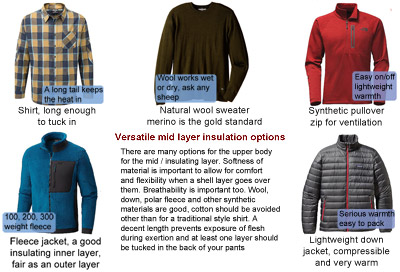Mid Layers - Insulation
Antarctic, Arctic and Mountain
Clothing
When layering clothes for cold weather, the mid layers should be insulating and versatile. When the sun shines and the wind drops even at low temperatures, they can become the outer layer and allow ventilation, likewise they should quickly close up to provide vital heat retention when the weather turns again.
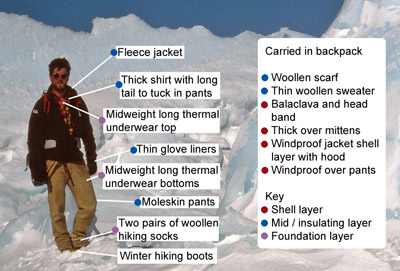
The mid layers of your clothes for extreme cold weather are perhaps more recognizable as "normal clothes" in a way that thermal underwear (foundation) and a heavyweight parka (shell) aren't so much.
To make them performance gear, you need to pay more attention to material and design than with your normal everyday clothes.
This picture is of me in Antarctica on a mild and calm late winters day at about -15C (+5F). It seems a good place to start talking about clothing layers as the sun and lack of wind meant it felt unusually warm for a while, with the potential for the wind to get up and temperature to drop again especially when the sun went down as it did early in the afternoon.
We walked across the sea-ice to visit some frozen-in icebergs, a 3 mile very rugged hike to get there then quite hard work over a couple of miles of broken flat ice with a substantial snow covering.
This added up to a day of varied temperatures, wind speeds, and activity levels, hard uphill walking and then sauntering about on the flat. There was always the possibility that Antarctica would deliver some hardcore Antarctic weather in a pretty short time that we needed to be prepared for. The clothing had to be versatile for changing conditions and up to the job of fending off the worst weather might bring.
Tops
Mid layers for the upper body. There are endless options that you can wear in cold climates to keep warm. More than one mid layer is usually worn for comfort and practical purposes, too many become unwieldy and can be restricting to movement. Two separate layers will be warmer than one of the same combined thickness and material due to air being trapped between as well as within layers.
The number of layers and level of insulation needed depends on the temperature and also on your own comfort level. For me this means two midlayers most of the time with another in my backpack in case it gets colder. Thicker, warmer layers for colder conditions mean that this number of layers can be fairly consistent. If the temperature goes up you can shed the shell layer and/or a midlayer depending on wind chill.
Adjustability for fit and ventilation is important, zips, buttons etc.
Preferred materials
Fleece - a polyester velour material, very breathable to provide comfort in all activities; does not restrict the movement of water vapor, dries quickly, machine washable, available in light, mid, and heavy weights for a choice of insulation level.
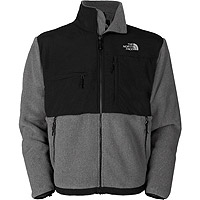
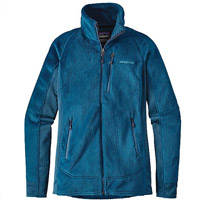
Men's fleeces:
Amazon
Moosejaw
Women's fleeces:
Amazon
Moosejaw
Wool - a natural material, good warmth for the weight and remains effective even when damp or wet. Merino wool is a particularly fine and soft grade. Insist on pure wool and avoid garments with acrylic or cotton which can look deceptively similar.

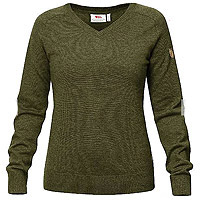
Men's wool sweaters:
Amazon
Moosejaw
Women's wool sweaters:
Amazon
Moosejaw
Down - a natural product, the best warmth for weight. New coatings are overcoming down's biggest shortfall which is performance when wet. As a mid-layer best with a rip-stop nylon outer, lightweight and compressible (often folds into its own pocket) , not particularly abrasion resistant.
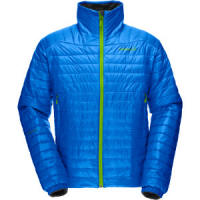
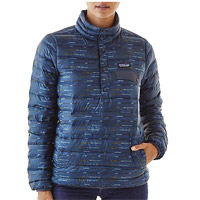
Men's lightweight down:
Amazon
Moosejaw
Women's lightweight down:
Amazon
Moosejaw
Synthetic insulation - similar to down but still warm when wet, the downside is a little heavier weight and greater bulk, e.g. thinsulate.
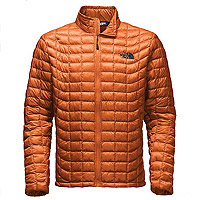
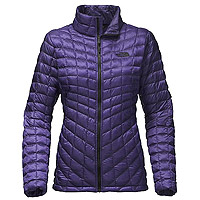
Men's lightweight synthetic:
Amazon
Moosejaw
Women's lightweight synthetic:
Amazon
Moosejaw
Synthetic fabrics - woven rather than used as insulation with loft. A number are available often with some stretchy material in the mix, avoid cotton mixes for cold climates.
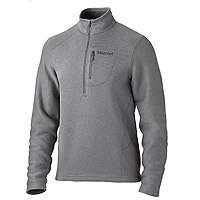
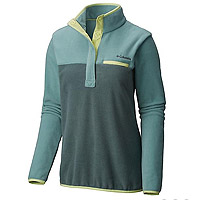
Men's knitted synthetics:
Moosejaw
Women's knitted synthetics:
Moosejaw
Best avoided
Softshell tops - garments with coatings and finishes to provide an element of wind proofing and water resistance. These provide some weather protection for activities in not-so-cold conditions but aren't wind or weatherproof enough to use as the shell layer and are less insulating than a similar fleece jacket, not so good for very cold conditions.
Cotton sweatshirts - Forget about that favorite sweatshirt you have, even the one advertising your allegiance to your sports team or alma mater. Heavyweight cotton does not make for a good mid-layer top garment.
Pants
Much of the time your pants are going to be an outer layer, so they need to be windproof. A degree of stretch aids comfort in use as does a soft lining material or brushed inner surface. It goes without saying that the material should be heavyweight for insulation which also aids durability. There are a whole range of modern materials, polyester, nylon and polyamide which can make great outdoors winter pants.
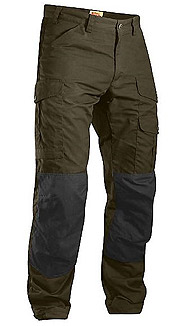
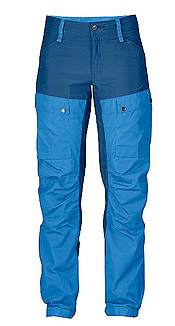
Men's winter pants:
Amazon
Moosejaw
Women's winter pants:
Amazon
Moosejaw
Softshell fabrics
are a good choice for winter pants, these have a reasonable
degree of weatherproofing against wind and light rain.
Unlike the top of your body, there is not the same need
for versatility in adding/removing layers or increasing
ventilation and your legs aren't going to sweat so much!
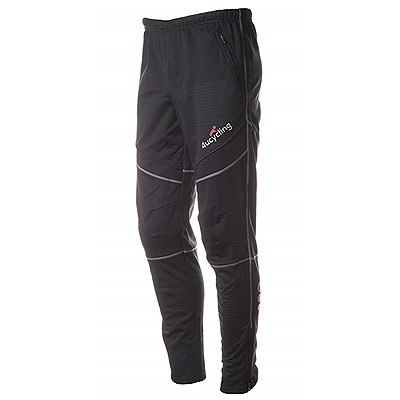
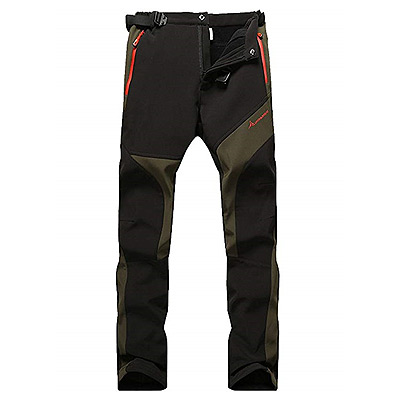
Men's softshell pants:
Amazon
Moosejaw
Women's softshell pants:
Amazon
Moosejaw
Insulated pants with already added insulation, for especially cold situations or to avoid putting the long underwear on for a while longer
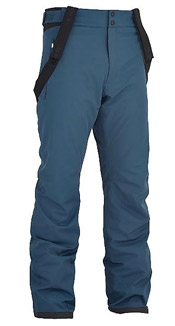
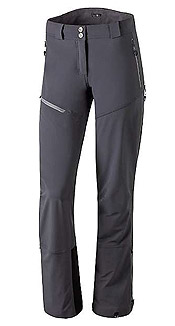
Men's insulated pants:
Amazon
Moosejaw
Women's
insulated pants:
Amazon
Moosejaw
Bibs / Bib-overalls, high pants with a chest panel and maybe a back panel too, they add extra insulation and keep you covered while bending or stretching, especially good for skiing and other dynamic high movement activities or where there is a chance of snow ingress at the waist. More for men than women as the shape errr.. fits better.
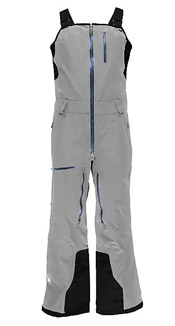
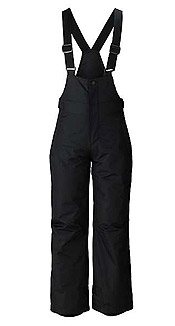
Men's bib pants:
Amazon
Moosejaw
Women's bib
pants:
Amazon
Moosejaw
 The
whole time I was in Antarctica I wore
moleskin pants,
a heavyweight brushed cotton fabric something I still
wear in the colder months and wouldn't consider wearing
anything else, for warmth, comfort and practicality
they have no rival (imho), they are not as long-term hardwearing
as synthetic materials though and tend to cost a little
more.
The
whole time I was in Antarctica I wore
moleskin pants,
a heavyweight brushed cotton fabric something I still
wear in the colder months and wouldn't consider wearing
anything else, for warmth, comfort and practicality
they have no rival (imho), they are not as long-term hardwearing
as synthetic materials though and tend to cost a little
more.
Men's
moleskins
Women's moleskins tend to be more "fashion"
that practical, you can find some here -
Women's moleskins.
The worst of all materials for winter pants is denim, cold and unforgiving to the touch at low temperatures it loves to hang on to water when it gets wet making it downright miserable and possibly dangerous adding to hypothermia risk.

